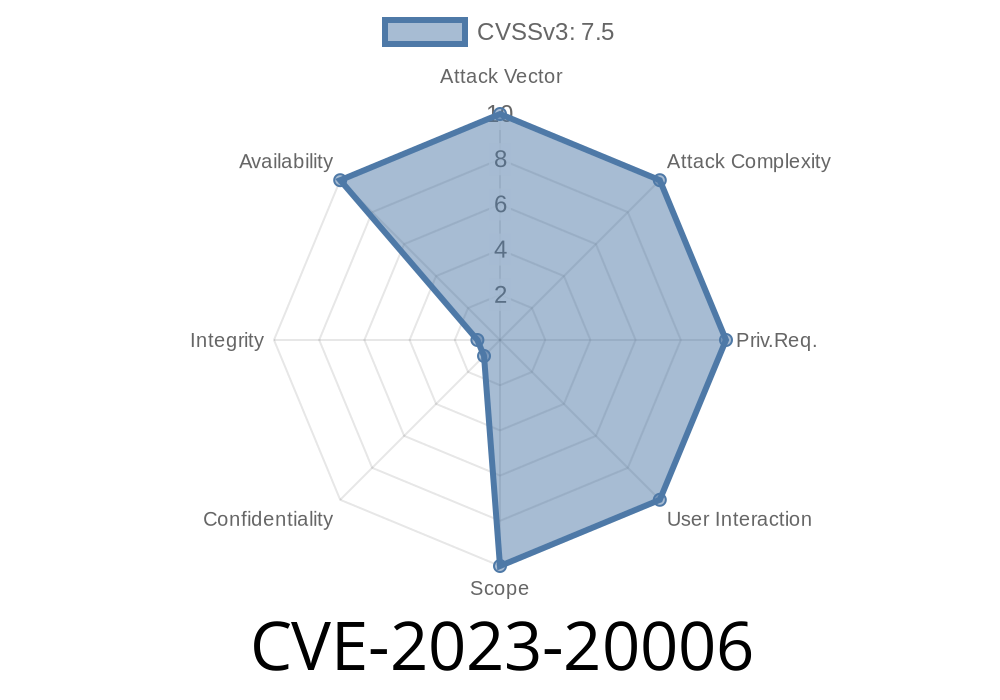In late 2023, Cisco disclosed CVE-2023-20006 — a critical vulnerability impacting the hardware-powered SSL/TLS cryptography of the Cisco Firepower 210 Series. This bug can let an unauthenticated, remote attacker crash the device, creating a denial of service (DoS). Let’s dig into how this works, what causes it, and how a bad guy could pull it off.
Cisco Firepower Threat Defense (FTD) Software on Firepower 210 Series
- Only if using hardware-accelerated SSL/TLS crypto (that’s default on these boxes!)
If you’re running a VPN, SSL decryption, or anything that handles SSL/TLS traffic (HTTPS, etc.), odds are, you’re at risk.
What’s the Bug?
At its core, this bug lives in the cryptography functions of the Cisco hardware. The processors that speed up SSL/TLS for busy firewalls have a flaw. When they receive a specially crafted SSL/TLS traffic stream (made with specific packet structures), their crypto engine can get confused and crash the whole device.
This denial of service doesn’t need a login, a session, or any valid traffic — any remote attacker with Internet access to your firewall or edge can start this attack.
The Vulnerable Code (A High-Level Concept)
While Cisco hasn’t published the precise code, here’s a Python-style pseudo-snippet showing what goes wrong conceptually:
def process_ssl_tls_record(record):
if not is_valid_tls_record(record):
# Instead of safely dropping it, hardware error triggers a crash
trigger_hardware_error()
# No error handling here; device will reload
def trigger_hardware_error():
# Sends malformed input to hardware crypto unit
# Unit panics and halts, causing full device reload
reload_device()
What should happen: The device quietly drops any weird inputs and keeps running.
What does happen: The hardware receives these weird inputs, triggers an error path, and the whole device reboots instead.
Find the public IP (VPN or firewall IP) of your vulnerable Firepower 210 or ASA.
2. Send purposely malformed SSL/TLS handshake data to it, repeatedly (not too fast, to elude rate limiting).
3. Device hardware chokes — the cryptography accelerator process fails, and the unit triggers a reload (reboot).
4. Firewall/IPS goes down for anywhere from 30 seconds to a few minutes.
If an attacker can keep doing this, they can essentially keep that device offline as long as they want.
Proof-of-Concept Traffic
You could use scapy or openssl s_client with custom parameters, but here’s a Python-like outline to generate malformed TLS packets:
from scapy.all import *
from scapy.layers.inet import TCP, IP
from scapy.layers.ssl_tls import TLS, TLSClientHello
# Craft a malformed ClientHello with intentionally broken structure
malformed_hello = TLS() / TLSClientHello(version=x303, gmt_unix_time=, random_bytes=b'X'*24)
ip = IP(dst="FIREWALL_IP")
tcp = TCP(dport=443, sport=RandShort(), flags="S", seq=100)
send(ip/tcp/malformed_hello, count=10, inter=.5)
That’s a *very* simplified example. The real exploit would need to hit the specific bug trigger — which, according to Cisco, is just “crafted SSL/TLS streams.”
No code execution, no data leak — straight DoS crash.
- The device reloads, leaving your firewall, VPN, or secure email gateways offline. If part of a cluster, it triggers a failover (possibly leaving a gap if all units are targeted).
References
- Cisco Security Advisory: CVE-2023-20006
- NIST NVD Record
- Firepower 210 Data Sheet (for hardware details)
Mitigation Tips
- Cisco patches: Update your ASA and FTD images ASAP with the fixed versions listed here.
- Restrict SSL/TLS access: If possible, use access-lists to block all but trusted sources.
- Consider switching to software crypto: In some setups, you can disable hardware offload (performance hit, but closes this bug).
Final Thoughts
This vulnerability is another reminder: *hardware acceleration and special-purpose cryptography are only as secure as their code*. Even without code execution, attackers can create service outages just by sending junk traffic. If you manage a Cisco Firepower 210 Series (or any ASA/FTD devices), patch now and stay vigilant — today’s edge box is tomorrow’s exploit target.
Timeline
Published on: 06/28/2023 15:15:00 UTC
Last modified on: 07/12/2023 16:15:00 UTC
